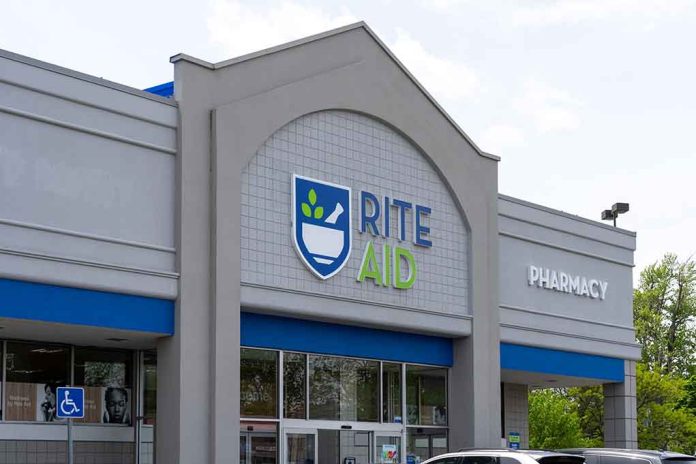
Rite Aid will shutter more than 1,000 pharmacy locations as the once-mighty drugstore chain slides back into bankruptcy for the second time in less than two years, signaling the demise of yet another American retail staple.
Key Takeaways
- Rite Aid is selling pharmacy assets from over 1,000 stores to competitors including CVS, Walgreens, Albertsons, Kroger, and Giant Eagle amid its second bankruptcy filing in less than two years.
- CVS Health is acquiring prescription files from 625 Rite Aid pharmacies across 15 states, with particular focus on Washington, Oregon, and Idaho locations.
- The transactions require approval from the U.S. Bankruptcy Court for the District of New Jersey, with a hearing scheduled for May 21, 2025.
- Rite Aid stores will remain open during the transition period to ensure uninterrupted pharmacy services for customers.
- As of the announcement, Rite Aid operated 1,240 stores, primarily in California, Pennsylvania, and New York, but the company is now discontinuing reward points and gift card honors.
Rite Aid’s Bankruptcy Spiral Deepens
Rite Aid has entered into a series of sale and pharmacy services transition agreements that will effectively dismantle the company’s retail footprint across America. The troubled pharmacy chain, which emerged from bankruptcy less than seven months ago, has filed for Chapter 11 protection again and is now selling prescription files and pharmacy assets from more than 1,000 locations to competitors. This strategic dismantling comes as the company faces insurmountable financial pressures and an inability to compete with larger pharmacy chains that have diversified their business models beyond traditional drug dispensing.
The sale represents a significant consolidation in the American pharmacy market, with retail giants CVS, Walgreens, and grocery chains like Kroger and Albertsons swooping in to acquire valuable prescription files while carefully avoiding taking on additional brick-and-mortar locations. This calculated approach by buyers demonstrates the industry’s growing wariness toward physical retail expansion at a time when online pharmacies and direct-to-consumer prescription services are gaining traction. The collapse of Rite Aid reflects broader challenges in the pharmacy sector where scale and diversification have become essential for survival.
CVS and Walgreens Lead the Asset Acquisition
CVS Health is positioned as the largest beneficiary in this dissolution, acquiring prescription files from 625 Rite Aid pharmacies spanning 15 states. Additionally, CVS will take over and operate numerous Rite Aid and Bartell Drugs locations throughout Washington, Oregon, and Idaho. This strategic acquisition strengthens CVS’s market position in the Pacific Northwest while simultaneously removing a competitor from the landscape. Walgreens and several grocery chains including Albertsons, Kroger, and Giant Eagle will absorb the remaining pharmacy assets, further consolidating the retail pharmacy market into fewer hands.
“A key priority for Rite Aid is to ensure that as many of our loyal customers as possible continue to receive the pharmacy services and care they require without interruption. These agreements ensure our pharmacy customers will experience a smooth transition while preserving jobs for some of our valued team members,” said Matt Schroeder, Chief Executive Officer of Rite Aid
Despite CEO Matt Schroeder’s reassurances about job preservation, the reality remains that only “some” employees will transition to the acquiring companies. This language signals significant job losses are inevitable as Rite Aid’s physical locations close. The company’s commitment to keeping stores open during the transition period demonstrates an attempt to maintain customer goodwill during the dismantling process, but the ultimate fate of the Rite Aid brand appears sealed. The transaction requires approval from the U.S. Bankruptcy Court for the District of New Jersey, with a hearing scheduled for May 21, 2025.
The Collapse of an American Retail Institution
Founded in 1962, Rite Aid’s decline represents another chapter in the ongoing transformation of American retail. As recently as the announcement, Rite Aid operated 1,240 stores primarily concentrated in California, Pennsylvania, and New York. The company’s inability to successfully navigate changing market conditions, coupled with overwhelming debt and legal challenges, has led to its current predicament. Customers are already feeling the impact as Rite Aid has discontinued its reward points program and stopped honoring gift cards, early indicators of a business in severe distress with no real path to recovery.
The transaction structure reveals an important industry trend: major pharmacy chains are seeking customer prescription files while avoiding additional physical infrastructure. This approach underscores the diminishing value of retail pharmacy real estate in an era of digital transformation and changing consumer preferences. For Rite Aid customers, the transition will require adaptation to new pharmacy providers, potentially disrupting established relationships with pharmacists and medication management systems. While acquiring companies have promised continuity of care, such large-scale transitions inevitably create challenges for vulnerable populations who rely on consistent pharmacy services.
Regulatory Scrutiny and Industry Implications
Beyond bankruptcy court approval, these transactions face potential regulatory scrutiny. The consolidation of pharmaceutical dispensing into fewer corporate entities raises legitimate concerns about market competition and consumer choice. Each transaction remains subject to regulatory notices, approvals, and customary closing conditions, which could potentially delay or modify the proposed arrangements. For the pharmacy industry as a whole, Rite Aid’s demise signals that mid-sized chains lacking robust diversification strategies may struggle to remain viable in a market increasingly dominated by healthcare conglomerates with integrated business models.
The collapse of Rite Aid stands as a stark reminder that long-established American retail institutions can quickly unravel when facing changing market dynamics. As these pharmacy assets transition to competing companies, thousands of employees face uncertain futures, communities lose familiar retail establishments, and the American pharmacy landscape grows increasingly concentrated. While the acquiring companies gain valuable prescription customers without the burden of physical stores, the ultimate cost will be borne by Rite Aid’s workers, investors, and loyal customers who must now adapt to a pharmacy market with one fewer option.









